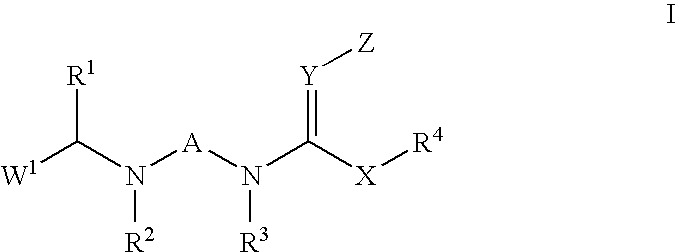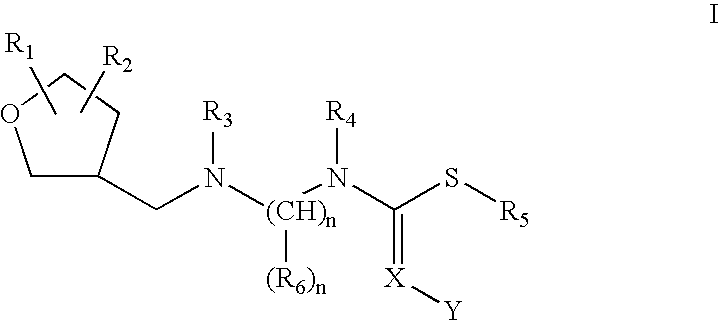Insecticidal N,N-Di(Heteroarylalkyl) Amine Derivatives
a technology of n-di (heteroarylalkyl) and derivatives, which is applied in the field of pesticidal compounds, can solve the problems of cosmetic injury to crop plants, loss of millions of dollars of value associated with crops, and in general insect damage to crops grown in agricultur
- Summary
- Abstract
- Description
- Claims
- Application Information
AI Technical Summary
Benefits of technology
Problems solved by technology
Method used
Image
Examples
example 1
This Example Illustrates One Protocol for the Preparation of [(6-chloro(3-pyridyl))methyl][2-(2-chloro-3-nitropyrrolyl)ethyl][4-methoxyphenyl)methyl]amine (Compound 188)
Step A Synthesis of 2-{[(6-chloro-3-pyridyl)methyl]amino}ethan-1-ol as an intermediate
[0112]A mixture of 20 grams (0.142 mole) of (6-chloro-3-pyridyl)formaldehyde and 31.3 grams (0.284 mole) of magnesium sulfate in 800 mL of 1,2-dichloroethane was stirred and 13.0 grams (0.213 mole) of 2-aminoethan-1-ol was added. Upon completion of addition, the reaction mixture was stirred for six hours, and 45.1 grams (0.213 mole) of sodium triacetoxyborohydride was added. Following the addition, the reaction mixture was stirred for about 72 hours, and then it was diluted with 250 mL of an aqueous solution comprised of 125 mL of an aqueous solution saturated with sodium chloride and 125 mL of water. The organic layer was separated and the aqueous layer was washed with ten 100 mL portions of 25% isopropanol in methylene chloride. T...
example 2
This Example Illustrates One Protocol for the Preparation of 2-{[(6-chloro(3-pyridyl))methyl][2-(2-ethylthio-3-nitropyrrolyl)ethyl]amino}ethanenitrile (Compound I)
Step A Synthesis of 2-{[(6-chloro(3-pyridyl)methyl](2-hydroxyethylamino}-ethanenitrile as an intermediate
[0119]A solution of 7.5 grams (0.0402 mole) of 2-{[(6-chloro-3-pyridyl)methyl]amino}ethan-1-ol (prepared in Step A of Example 1) in 100 mL of acetonitrile was stirred and 13.0 grams (0.1000 mole) of ethyldiisopropylamine was added, followed by 7.4 grams (0.0442 mole) of iodoacetonitrile. Upon completion of addition the reaction mixture was warmed to 80° C. where it was maintained for a six-hour period. After this time the reaction mixture was allowed to cool to ambient temperature as it stirred during an 18-hour period. The reaction mixture was then concentrated under reduced pressure to a residue. The residue was dissolved in methylene chloride and washed with one 50 mL portion of aqueous 5% sodium carbonate and with o...
example 3
This example illustrates one protocol for the preparation of {2-[2-(dimethylamino)-3-nitropyrrolyl]ethyl}[(6-chloro(3-pyridyl))methyl][(4-chlorophenyl)methyl]amine (Compound 214)
Step A Synthesis of 2-{[(6-chloro(3-pyridyl)methyl][(4-chlorophenyl)methyl]amino}ethan-1-ol as an intermediate
[0123]This compound was prepared in a manner analogous to that set forth in Step A of Example 1, using 5.0 grams (0.0268 mole) of 2-{[(6-chloro-3-pyridyl)methyl]amino}ethan-1-ol (prepared in Step A of Example 1), 3.8 grams (0.0268 mole) of 4-chlorobenzaldehyde, 8.5 grams (0.040 mole) of sodium triacetoxyborohydride and 6.5 grams (0.053 mole) of magnesium sulfate in 100 mL of 1,2-dichloroethane. The crude product was purified with column chromatography on silica gel. Elution was accomplished using 2% methanol in methylene chloride as an eluant. The appropriate fractions were combined and concentrated under reduced pressure, yielding 7.9 grams of the subject compound. The NMR spectrum was consistent wi...
PUM
| Property | Measurement | Unit |
|---|---|---|
| Ri | aaaaa | aaaaa |
| temperature | aaaaa | aaaaa |
| temperature | aaaaa | aaaaa |
Abstract
Description
Claims
Application Information
 Login to View More
Login to View More - R&D
- Intellectual Property
- Life Sciences
- Materials
- Tech Scout
- Unparalleled Data Quality
- Higher Quality Content
- 60% Fewer Hallucinations
Browse by: Latest US Patents, China's latest patents, Technical Efficacy Thesaurus, Application Domain, Technology Topic, Popular Technical Reports.
© 2025 PatSnap. All rights reserved.Legal|Privacy policy|Modern Slavery Act Transparency Statement|Sitemap|About US| Contact US: help@patsnap.com



